Have you ever noticed how quickly time flies when you’re absorbed in a fun game? Numerous studies, like this article on the effects of digital game-based learning, have shown that this powerful engagement can be harnessed to raise classroom engagement to a whole new level. These findings, along with a great many others, highlight the significant impact of game-based learning on student motivation and participation.
Imagine utilizing that same level of enthusiastic focus to boost learning in the classroom. That's the core idea behind game-based learning.
But what exactly is game-based learning (GBL), and is it the same as gamification? Not quite! Many may mistake the two as the same due to the use of the word “game”, but each teaching approaches learning from fundamentally different angles. Let’s dive into the world of educational games and uncover the exciting potential of game-based learning for teachers and students alike.
What is Game-Based Learning? More Than Just Learning with Games
In a nutshell, game-based learning is a comprehensive approach that utilizes games to enhance the learning process. It leverages game-like elements to create effective learning experiences that promote deeper understanding and knowledge retention.
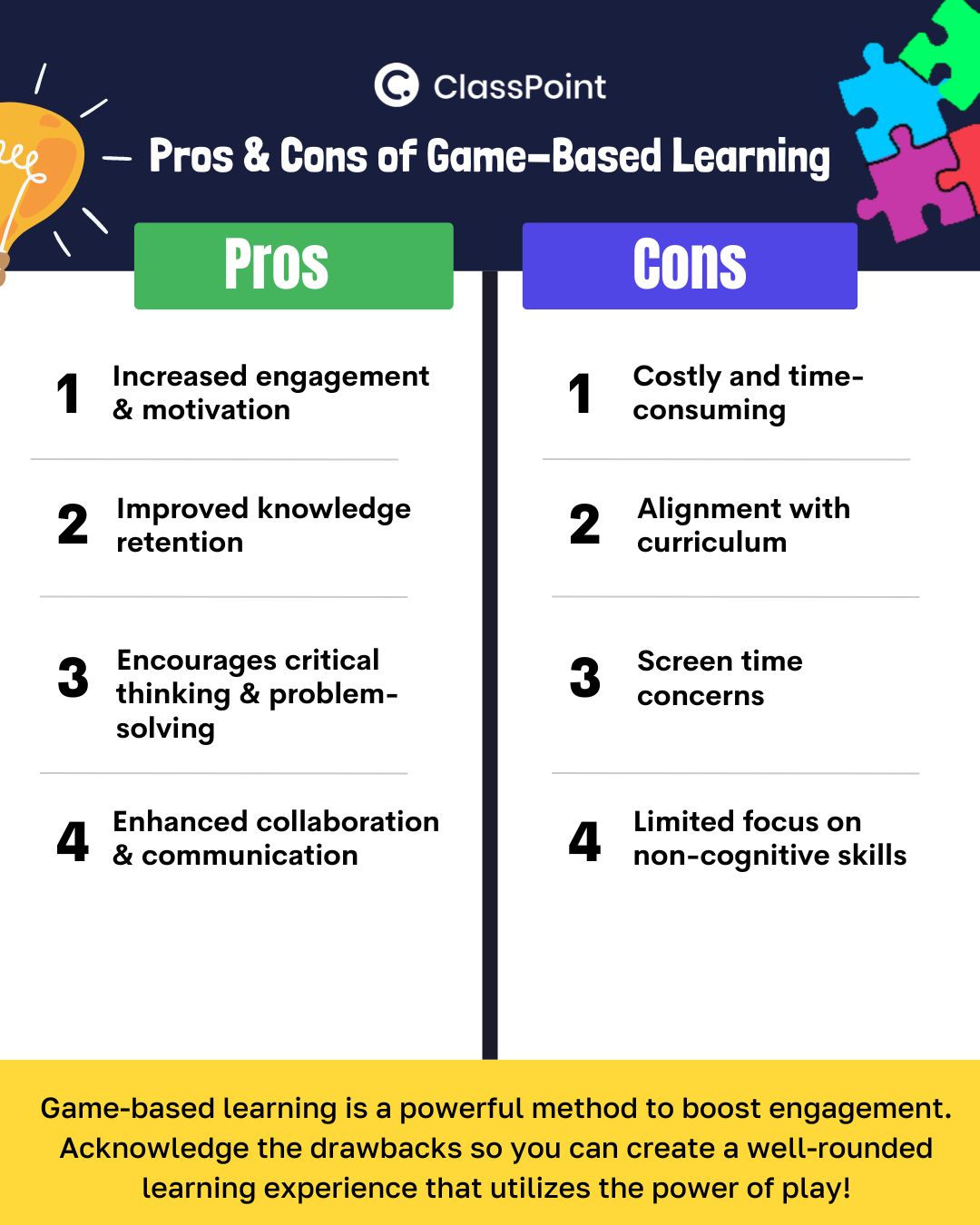
Examples of Game-Based Learning Based on Subjects
Language Arts
- Vocabulary Games: Students can play online vocabulary games where they drag and drop words to definitions or complete sentences with missing words. These games can be tailored to specific reading lists or themes.
- Interactive Storytelling: Students can participate in creating stories collaboratively through online platforms or role-playing games. These activities encourage creativity, writing skills, and critical thinking.
- Grammar Quiz Competitions: Transform grammar practice into a game show experience with online quizzes inspired by Wheel of Fortune and Family Feud. These competitions offer points, leaderboards, and badges for correct answers.
Here’s how to run an online quiz competition in PowerPoint in just a few simple clicks.
Math
- Math Simulations: Students can explore real-world applications of math concepts through simulations, like managing a virtual lemonade stand to understand concepts like profit and loss, or navigating a spaceship using geometric principles.
- Math Arcade Games: Educational games can transform basic math operations like addition, subtraction, multiplication, and division into engaging arcade-style experiences. These games can help students develop fluency and build confidence.
- Interactive Problem-Solving Activities: Platforms can offer problem-solving scenarios where students have to apply math concepts to find solutions. These activities encourage critical thinking and logical reasoning.
Science
- Science Simulations: Students can delve into scientific phenomena through interactive simulations. Imagine conducting virtual experiments on weather patterns or exploring the human body through a 3D model.
- Science Trivia Games: Review key science concepts through online quizzes that incorporate elements of competition and instant feedback. Challenge students with a Jeopardy-inspired review game to reinforce key concepts.
Download our free Trivia PowerPoint template to run an interactive trivia game in PowerPoint.
- Classification Challenges: Students can participate in online games where they have to classify objects or organisms based on specific scientific criteria.
History & Social Studies
- Historical Simulations: Immerse students in historical events through role-playing games. Students can take on the roles of historical figures and make decisions that impact the course of history.
- Interactive Timelines: Platforms can offer interactive timelines and roadmaps where students can explore historical events by clicking on different periods and uncovering information through multimedia elements.
- Geography Challenges: Educational games can test students’ geographical knowledge through quizzes, map-based activities, or virtual tours of different countries and cultures.
Benefits of Game-Based Learning
Game-based learning offers a myriad of benefits for students, transforming classrooms from passive learning environments to engaging adventures. Here’s how learning with games can revolutionize the learning experience:
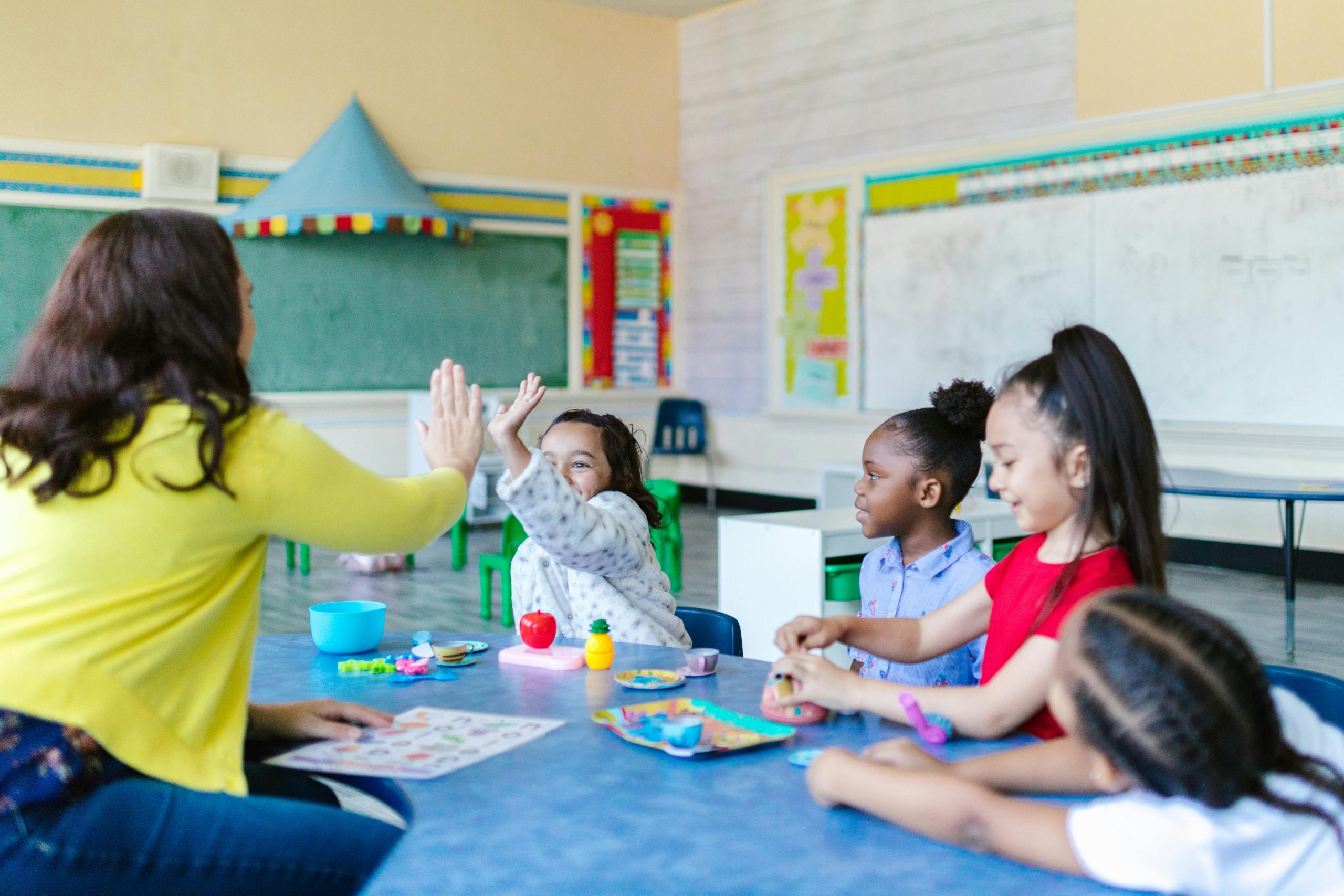
Increased engagement & motivation
Games tap into our natural desire for challenge and reward. GBL replaces rote memorization with active participation, fostering a more positive learning environment. Students become more invested as the game progresses, leading to a deeper interest in the subject matter. This intrinsic motivation fuels their desire to learn and explore further.
Improve Knowledge Retention
But the benefits go beyond simply capturing student interest. The interactive nature of these games allows for improved knowledge retention. By practically applying concepts, students solidify their understanding and create long-lasting memories. GBL experiences often require students to solve problems, make decisions, and navigate challenges within the game. This process helps them build connections between concepts and create a more robust knowledge base.
Encourages Critical Thinking & Problem-Solving
GBL also equips students with valuable skills that extend far beyond the classroom. Many game-based learning games require strategic approaches and creative solutions to overcome obstacles, fostering the development of critical thinking and problem-solving skills. As students navigate challenges within the game, they learn to analyze situations, develop solutions, and adapt their strategies. These valuable skills prepare them to tackle real-world problems with confidence.
Enhanced Collaboration & Communication
Finally, game-based learning can promote collaboration and communication. Some GBL experiences are designed to encourage teamwork. Students work together, communicate effectively, and strategize as a team to achieve success. This collaborative approach fosters valuable social and communication skills that are essential for success in both academic and professional settings. Game-based learning games encourage students to work together, fostering a sense of teamwork and communication.
The Challenges of Game-Based Learning
While game-based learning offers a treasure trove of benefits for student engagement and learning, it’s important to acknowledge some potential challenges.
Investment of Time and Resources
One concern is the cost and time associated with familiarizing ourselves with the mechanics of a game. Additionally, some GBL platforms may require a subscription fee, which needs to be factored into budget considerations.
Alignment with Curriculum
Educators also need to carefully evaluate GBL options to ensure they align with their specific curriculum and learning objectives. Not all games are created equal, and some may not perfectly match the intended educational goals.
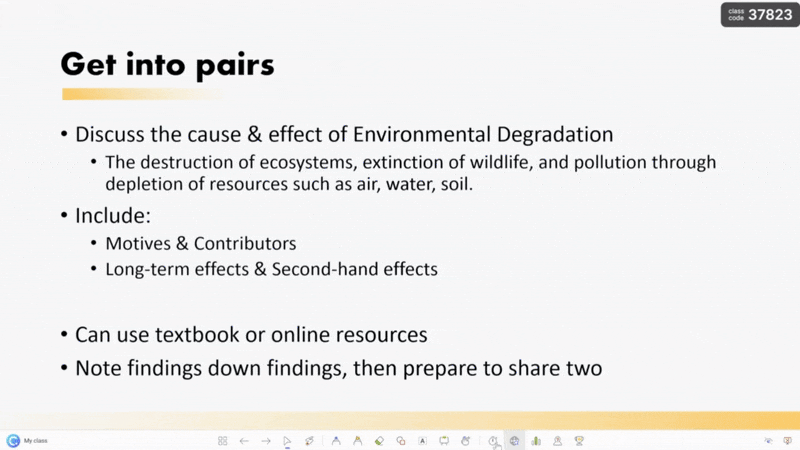
Screen Time Management
Another consideration is screen time. An overreliance on online games can lead to increased screen time for students, which may have its own set of drawbacks. Finding a healthy balance between game activities and other forms of learning that involve less screen time, such as discussions, group projects, or hands-on activities, is crucial.
Pro Tip: Keep time of classroom activities or games with ClassPoint's timer for a more productive lesson.
Addressing Non-Cognitive Skills
While some GBL experiences excel at promoting critical thinking and collaboration skills, they may not always explicitly target non-cognitive skills like social-emotional learning or communication. Educators may need to supplement GBL activities with lessons or projects that specifically address these areas to ensure a well-rounded learning experience.
By acknowledging these potential drawbacks, educators can make informed decisions about how to integrate game-based learning games effectively into their teaching strategies. The key lies in finding the right balance between GBL and other instructional methods to create a comprehensive and engaging learning environment for students.
Gamification vs Game-Based Learning Explained
While both game-based learning and gamification aim to increase engagement and participation, there’s a key distinction between the two. Game-based learning prioritizes learning objectives, using the game as the primary learning tool. Gamification, on the other hand, focuses on making existing activities more engaging by adding gamified elements.
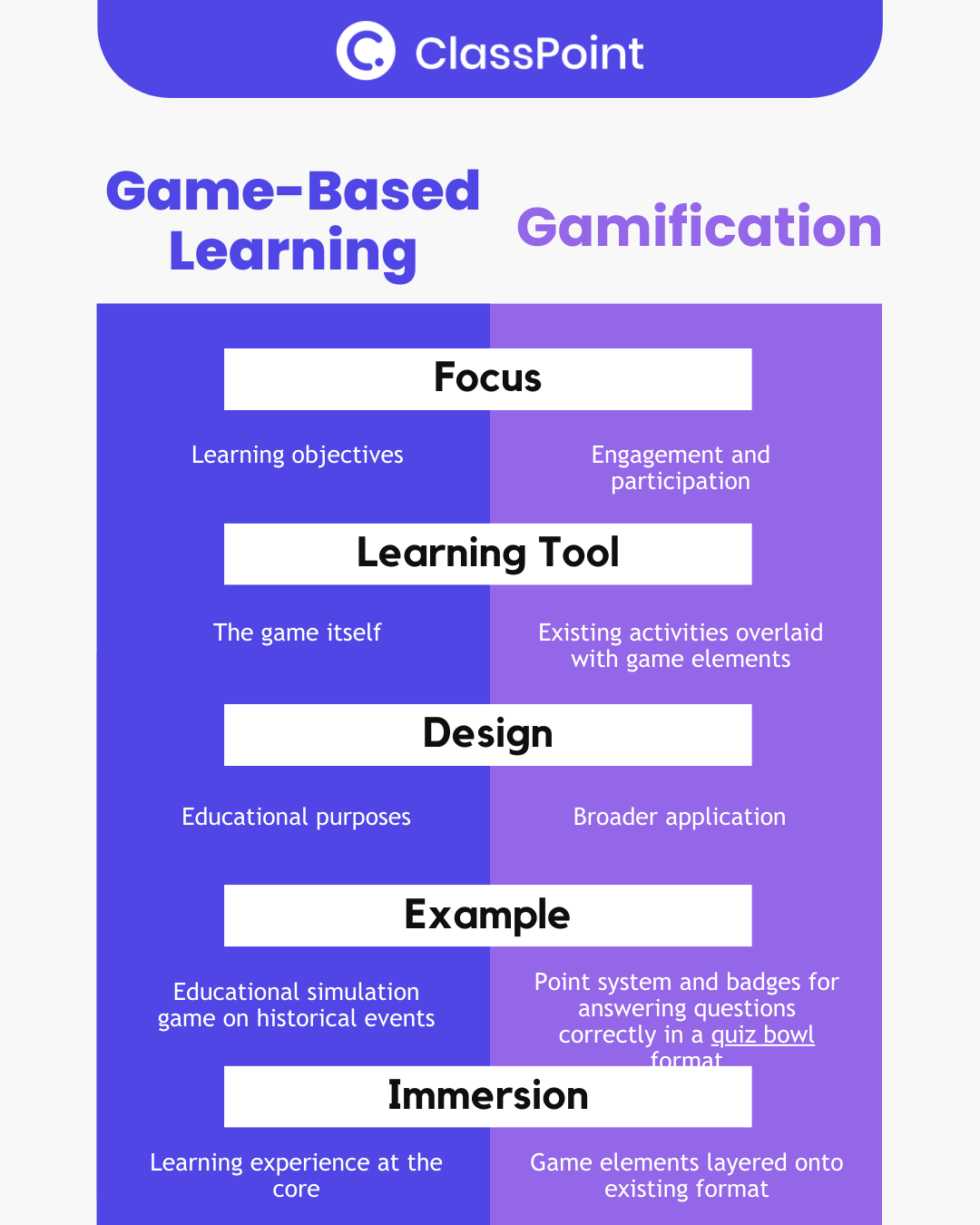
How Technology Elevates Game-Based Learning & Gamification
Both game-based learning and gamification use games and game-like features to make learning fun and boost student participation. But how can we make them even more effective? This is where education technology can play a part. Let’s see how technological advancement can increase the efficacy of both GBL and gamification.
- Automated Mechanics: Tech tools can automate tasks like point allocation, badge awarding, and leaderboard updates, freeing up teachers’ time to focus on instruction and student interaction.
- Data Analytics: Gamified learning platforms like ClassPoint can provide educators with valuable data on student performance and engagement. This data can be used to refine the gamification strategies and personalize the learning experience.
Automatically award stars to participants with ClassPoint's Quiz Mode for MCQ.
- Personalized Learning: Technology can personalize GBL experiences by adapting the difficulty level or content based on individual student progress. This ensures a more engaging and effective learning journey for each student.
Try these 25 recommended modern differentiated instruction strategies for a more personalised classroom teaching.
- Real-time Feedback & Assessment: GBL platforms can provide students with immediate feedback on their performance within the game, allowing them to adjust their strategies and solidify their understanding.
- Engaging Design: Technology allows for the creation of visually appealing and interactive gamified elements, further enhancing the motivational power of gamification.
- Advanced Simulations: Educational games can leverage virtual reality (VR) or augmented reality (AR) to create immersive simulations that bring abstract concepts to life. Imagine students exploring the human body in VR or conducting virtual experiments in a science simulation.

Leveraging Game-Based Learning and Gamification in Your Classroom
If you’re interested in applying game-based learning to your curriculum, the time to try is now. While game-based learning platforms offer fantastic opportunities for immersive learning experiences, incorporating gamification elements can further enhance your existing curriculum. Think of gamification as the secret sauce that adds an extra layer of engagement.
Tools like ClassPoint allow you to seamlessly integrate game mechanics like stars, badges, and leaderboards into your presentations or activities.
Craft Interactive Quizzes & Assessments
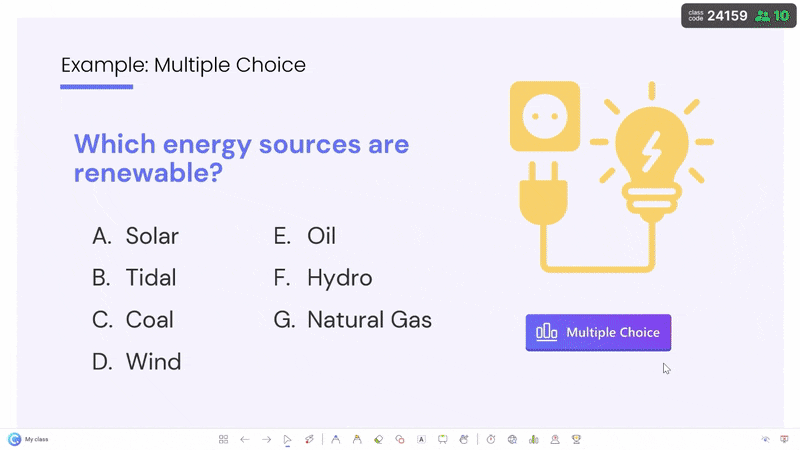
Boring assessments are a thing of the past. Design interactive quizzes with various question types, from multiple-choice to open-ended and image-based questions. Students can participate in real-time, and you can receive instant feedback on their understanding, allowing you to adjust your teaching accordingly. You can convert a history presentation into a thrilling trivia competition or turn a science lesson into a collaborative quiz show – all directly within your existing slides.
Supercharge Engagement with Gamification Elements
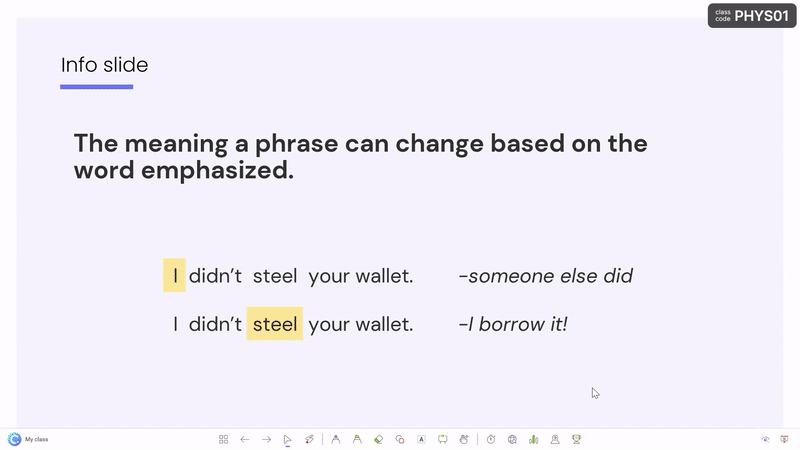
ClassPoint goes beyond simply incorporating gamified features. You can easily add captivating gamification elements like leaderboards, badges, and point systems to your presentations. For example, awarding a star when a student participates. These elements of friendly competition add another layer of engagement, making learning a truly stimulating experience.
Run Quick and Fun Game Sessions in PowerPoint
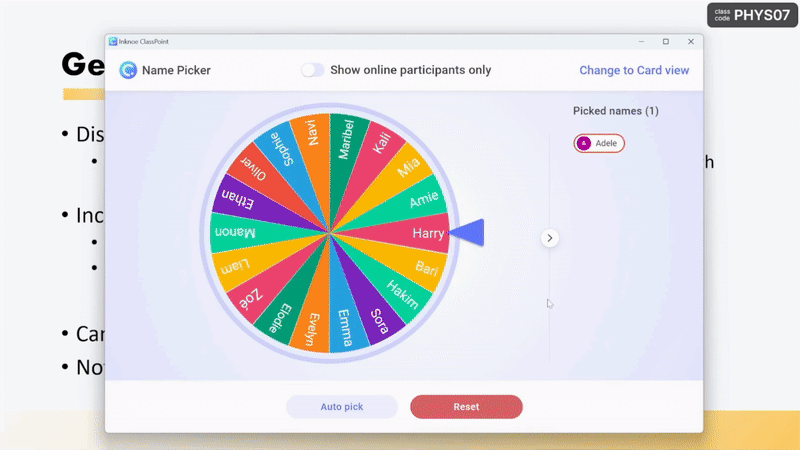
Whether it is a trivia showdown, games inspired by popular American game shows like Family Feud, Wheel of Fortune, and Jeopardy, or low-prep classroom games turning your PowerPoint into a game arena has been easier than ever. Randomly group students into teams, and incorporate these games into your PowerPoint teaching to effectively promote active participation and knowledge retention among your students or participants!
Final Thoughts
The traditional classroom is evolving and educators should partake in the revolution. Gone are the days of rote memorization and passive learning, and with both game-based learning and gamification, you can transform classrooms into engaging and interactive spaces. By harnessing the power of play and friendly competition, educators can ignite a passion for learning in their students.
Embracing these trends also doesn’t require a complete overhaul of your curriculum. A wealth of resources is available, from game-based learning platforms to tools that can integrate gamification elements into existing lessons. This flexibility allows educators to tailor their approach, creating a learning environment that best suits their students and lesson plans.
By applying these methods, teachers can empower students to become active participants in their educational journey. Learning shouldn’t feel like a chore, and with game-based learning, it won’t have to.
